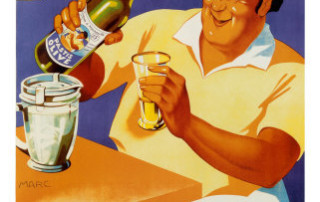This section tells you more about famous French artists: singers, actors, writers, poets or painters.
Do you know Philippe Katerine?
Philippe Katerine, known simply as “Katerine” in France, is a French singer-songwriter, artist and author, best known for his boundary pushing music.
With his offbeat lyrics and kitsch costumes that would put Austin Powers to shame, Katerine is gyrating proof that the French can do irony after all.
In his years in the music business he’s progressed from easy listening to electro pop.
The 44-year-old, who comes from the commune of Chantonnay in the Vendée department of Pays de la Loire in western France, has also directed and starred in films and written a book.
Why is he in the news?
His new song ‘Sexy Cool’ – released earlier this month – was this week declared France’s “summer dance anthem” by the French media.
The track, which features on the pop star’s forthcoming ninth album ‘Magnum’ to be released on October 14th, is an ironic summer music video in which Katerine sings about how “sexy” and “cool” he is.
Tell me more about him.
Unsurprisingly, Katerine is no stranger to strange headlines.
In April 2012, the artist experimented in a new form of artistic expressionism when he was invited by the upmarket Paris-based department store Galeries Lafayette to display his artwork in an exhibition entitled ‘Comme un ananas’ (‘Like a pineapple’).
In 2011, the artist also made a splash when he published the book ‘Doublez votre mémoire’(‘Double your memory’) under the alias Philippe Bouchard. Presented as a kind of artistic diary, the book is described by its editor as “a unique work, worthy of the best artist notebooks” consisting of “narcissistic inspirations and schoolboy outbursts”.
Since 2000, Katerine has also acted in many films and even directed two of his own.
So what’s so sexy and cool about ‘Sexy Cool’?
Well perhaps it’s the cheesy dance routine, the catchy lyrics as well the 70s costumes and mustache.
If you find yourself on a dance floor in a French disco this summer you will probably here these lyrics: “Je suis cool quand t’es cool/Je suis triste quand t’es triste/Je suis stress quand tu stresses/Je suis sexy quand tu es sexy”. In other words: “I’m cool when you’re cool/I’m sad when you’re sad/I’m stressed when your stressed/I’m sexy when you’re sexy” (in case you want to sing along).
What about the other tracks on the album?
Another cheesy delight is ‘Banane’ (below), featuring Katerine parading around on a beach holding a banana dressed in nothing but a white sheet as he sings: “No, leave me/To eat my banana naked on the beach”. In another scene hundreds of people dance along to the tune whilst waving a banana in the air.
Again it’s better to let you watch the video for yourselves.
What does he have to say for himself?
Why don’t we let this translation of a typically, shall we say unsophisticated, extract from another single on his upcoming album, ‘Efféminé’, speak for itself?
“With my big b***s/I go to the casino/With my big b***s/I buy myself a Kinder Bueno/With my big b***s/I call my beloved/She laughs/Because I’m effeminate.”
What do others say about him?
“Philippe Katerine has forced us to become accustomed to his style, by flouting all conventions, fluctuating between total nonsense and misunderstood genius,” wrote Le Figaro newspaper.
After all, says the paper, “who can boast of having dared as much as Katerine to push and play with the borders of pop which are all too often sterilized and formatted,” adding “You could dance all night [to his songs] if the lyrics weren’t so crude.”






